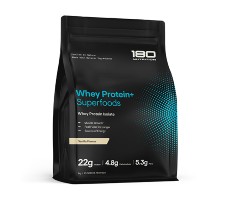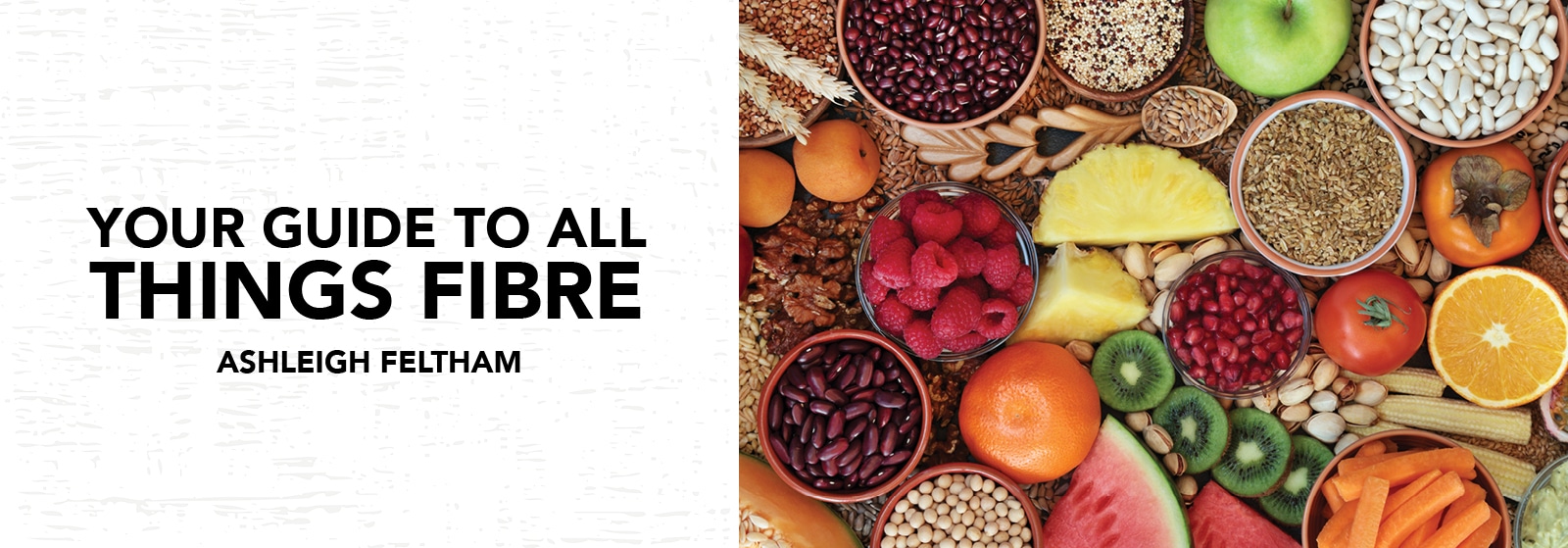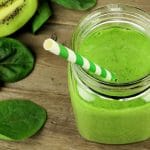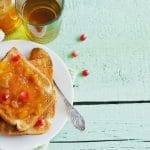Do you feel lost by all the information online on fibre? If you are looking for a blog which will help you understand all the basics around fibre this is a must-read blog for you. Fibre is a type of carbohydrate which your body cannot digest but plays essential roles in keeping your body functioning. An adult is recommended to include between 25-38g of dietary fibre each day for health. Research suggests that over 70% of adults and over 50% of children in Australia are not getting the recommended amount of daily fibre needed for health (Fayet-Moore F et al, 2018).
Some of the health benefits of including enough fibre include:
- Fibre can help you achieve and maintain a healthy body weight by helping you to feel fuller for longer. By keeping you feeling fuller for longer fibre can help you achieve a calorie deficit and help you to lose weight.
- Keeping your guts functioning optimally.
- Food for the health promoting microbes.
- Helps to lower blood pressure which supports heart health.
- Helps to reduce blood sugar levels.
- May reduce your risk of certain cancers such as colorectal cancer. Research suggests that for every 10g of dietary fibre increase in your diet there is a 10-11% decreased risk of developing colorectal cancer (Ma Y et al, 2018).
- May help to reduce chronic inflammation.
- Promotes healthy cholesterol levels by reducing your ‘bad’ LDL cholesterol. This supports your heart health.
There are three types of fibre: soluble, insoluble, and resistant starch. All three of these types play a different role in helping to keep your body healthy. Find out the differences between soluble and insoluble fibre below.
1. Soluble Fibre
This is the type of fibre which acts like a bulking agent to make your stool comfortable to pass. How this fibre type works is it slows how quickly the carbohydrate you eat is broken down; this not only keeps you fuller for longer but prevents the unwanted spike of your blood sugar. A type of soluble fibre called beta glucan can also help to lower your ‘bad’ LDL- cholesterol. Beta glucan attaches to your LDL-cholesterol and ultimately is removed when you visit the bathroom.
Soluble fibre can also act as a prebiotic or a fuel source for the health promoting microbes in your body. When the health promoting microbes eat prebiotic fibre, they produce compounds such as short chain fatty acids which have different health benefits for your body.
All plant-based foods have some form of soluble fibre. Plant foods which have a high amount of soluble fibre include:
- Oats
- Legumes (kidney beans, chickpeas, soybeans etc.)
- Konjac
- Fruit and vegetables (especially in the flesh which is why you should try to eat the skins of fruits and vegetables whenever possible).
2. Insoluble Fibre
This type of fibre is your friend especially if you are prone to constipation as it helps you stay regular. This type of fibre is often found in the outer components of plant-based foods which is why it is important to eat the whole plant-food if possible, for your health.
Types of plant-based foods with a high amount of insoluble fibre include:
- Wheat bran
- Brown rice
- Wholegrain cereals
- Wholegrain pastas
3. Resistant Starch
Like soluble fibre, resistant starch can also promote the development of the health promoting microbes living in your gut. Some of the health benefits associated with having a healthy gut microbiome include supporting an optimal immune system and a healthy metabolism which supports you having a healthy weight. There is a direct link from your brain to your gut called the gut-brain axis. This means that the health of your gut can impact the health of your brain and consequently may impact your mental health.
70% of the serotonin or the ‘feel-good’ hormone is made in your guts.
As a general guideline it is recommended to include 15-20g of resistant starch each day. All starchy foods are a source of resistant starch. Foods which are good sources of resistant starch include:
Some of the foods rich in resistant starch include:
- Unripened bananas
- Onions
- Cooked and cooled wholegrain pasta, potatoes, and rice and wholegrain varieties.
- Legumes like chickpeas, lentils, and red kidney beans.
- Starchy vegetables like pumpkins, potatoes, and sweet potatoes.
- Nuts
Remember To Pair Fibre with Fluids
For your body to get the full benefits fibre can provide it needs to be paired with enough fluids. Insoluble fibre acts to trap the fluid and uses it to increase the rate of transition through the gut. Increasing your stool frequency can decrease your risk of developing colorectal cancer by decreasing the amount of time potentially harmful substances stay in your gut. Not having enough fluid can make gut symptoms like constipation worse (Ma Y et al, 2018).
Soluble fibre also needs fluid but uses fluid to help to form a gel like substance. Fibre and fluid work together to reduce how quickly sugar is taken into your bloodstream. Soluble fibre also slows the transit of food out of your stomach, keeping you feeling fuller for longer.
Tips to Help You Achieve Your Daily Fibre Needs
1. Read the food label on your cereal box
Aim to select foods which have 3-6g of fibre per serve.
2. Aim to Include More Wholegrains
Try replacing white and refined breads, rice and pasta for wholegrain bread and pasta or brown, black, or red rice. Also try enjoying wholegrain couscous or quinoa.
3. Enjoy A Few Meat Free Meals
Legumes/beans like kidney beans (yes baked beans count), chickpeas and lentils are not only fantastic for your guts but eating less meat, especially red and processed meat may reduce your risk of cancers like colorectal cancer.
4. Get your 2 and 5
Roughly around 4% of people are eating the recommended 2 serves of fruit and 5 serves of vegetables daily. Aim to keep the skin on fruits and vegetables as this will increase the amount of insoluble fibre your body receives as well as add extra crunch and flavour.
5. Go Nuts for Nuts and Seeds!
30g of nuts and/or seeds, which is about a small handful, is a great source of many healthy vitamins and minerals for your body. This includes healthy fats, protein, and fibre to keep you feeling fuller for longer. There has been research which supports that eating a small handful a day helps decrease the size of your waistline (Li H et al,2018). Try the unsalted variety to help your blood pressure but any nut is a good nut!
By eating an overall balanced diet which focuses on plant-based foods you should be able to meet your daily dietary fibre needs. Below is an example of a day of eating to meet dietary fibre needs.
Breakfast
½ cup of rolled oats with 1 cup of fruit = 6.4g fibre
Snack
Apple = 3.5g fibre
30g almonds = 4g fibre
Lunch
Wholegrain cheese and salad wrap with 2 cups of salad vegetables = 7.5g fibre
Snack
Reduced salt baked beans (130g) = 4.7g fibre
Dinner
Beef stir fry with 1 cup of cooked brown rice and 1.5 cups of cooked vegetables = 4.5g fibre
Total Daily Fibre = 30.6g
Take home message: Keep your body running like a well-oiled machine by giving it the daily dietary fibre it needs to function and thrive.
Want to find out more about the importance of fibre?
We think you will enjoy this article, “6 Surprising Reasons Why Fibre Is Vital In Your Daily Diet“.
References:
- Fayet-Moore F, Cassettari T, Tuck K, McConnell A, Petocz P. Dietary Fibre Intake in Australia. Paper I: Associations with Demographic, Socio-Economic, and Anthropometric Factors. Nutrients. 2018 May 11;10(5):599. doi: 10.3390/nu10050599. PMID: 29751656; PMCID: PMC5986479.
- Resistant Starch Facts. CSIRO. https://www.csiro.au/en/research/health-medical/nutrition/resistant-starch
- de Vries J, Le Bourgot C, Calame W, Respondek F. Effects of β-Fructans Fiber on Bowel Function: A Systematic Review and Meta-Analysis. Nutrients. 2019 Jan 4;11(1):91. doi: 10.3390/nu11010091. PMID: 30621208; PMCID: PMC6356805.
- Wu et al., The Gut Microbiota in Prediabetes and Diabetes: A Population-Based Cross-Sectional Study. Cell Metabolism. 2020; 32, 1–12. https://doi.org/10.1016/j.cmet.2020.06.011
- Huang, X., Wang, X., Shang, J., Lin, Y., Yang, Y., Song, Y., & Yu, S. (2018). Association between dietary fiber intake and risk of ovarian cancer: a meta-analysis of observational studies. The Journal of international medical research, 46(10), 3995–4005. https://doi.org/10.1177/0300060518792801
- Zheng B, Shen H, Han H, Han T, Qin Y. Dietary fiber intake and reduced risk of ovarian cancer: a meta-analysis. Nutrition Journal. 2018;17.
- Anti M, Pignataro G, Armuzzi A, Valenti A, Iascone E, Marmo R, Lamazza A, Pretaroli AR, Pace V, Leo P, Castelli A, Gasbarrini G. Water supplementation enhances the effect of high-fiber diet on stool frequency and laxative consumption in adult patients with functional constipation. Hepatogastroenterology. 1998 May-Jun;45(21):727-32. PMID: 9684123.
- Caleigh M Sawicki, Paul F Jacques, Alice H Lichtenstein, Gail T Rogers, Jiantao Ma, Edward Saltzman, Nicola M McKeown. Whole- and Refined-Grain Consumption and Longitudinal Changes in Cardiometabolic Risk Factors in the Framingham Offspring Cohort. The Journal of Nutrition, 2021; DOI: 10.1093/jn/nxab177
- WCRF/AICR World Cancer Research Fund / American Institute for Cancer Research. Continuous Update Project Interim Report Summary. Food, Nutrition, Physical Activity, and the Prevention of Colorectal Cancer. 2011
- (Ma Y, Hu M, Zhou L, Ling S, Li Y, Kong B, Huang P. Dietary fiber intake and risks of proximal and distal colon cancers: A meta-analysis. Medicine (Baltimore). 2018 Sep;97(36):e11678. doi: 10.1097/MD.0000000000011678. PMID: 30200062; PMCID: PMC6133424.)
- Li H, Li X, Yuan S, Jin Y, Lu J. Nut consumption and risk of metabolic syndrome and overweight/obesity: a meta-analysis of prospective cohort studies and randomized trials. Nutr Metab (Lond). 2018 Jun 22;15:46. doi: 10.1186/s12986-018-0282-y. PMID: 29977320; PMCID: PMC6013998. 2018.







